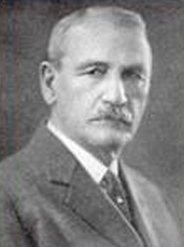
"A collision has its good points as well as its bad ones — it indicates there is something moving on the railroad."
Born in West Gardiner, Maine, John Frank Stevens studied to be a teacher at a normal school. He had no technical training when, at the age of 21, he decided to move west and take a job in the Minneapolis city engineer's office. Later he went into the burgeoning field of railroad location and construction in several western states. He undertook his first major engineering assignment in 1883, as an assistant to the chief engineer responsible for scouting locations for the Canadian Pacific Railroad's crossing of the Rocky Mountains. His work in Canada brought him to the attention of James J. Hill, who had ambitious plans to link the Midwest with the Pacific Northwest via a route south of the Canadian border. He needed someone to find the best route through the mountains. Legend and rumors suggested there was a suitable pass near the headwaters of the Marias River, but no one was sure exactly where to find it.
Stevens set out from Havre, Montana, in November 1889, with a mule team, some cobbled-together snowshoes, and an Indian companion to try to find the pass. Before many days had passed, the mule team began to flounder in the deep snow and had to be left behind. After several more miles and the discovery of two dead-ends, the Indian told Stevens that he would not go on. But Stevens persisted, leaving his companion with a fire for warmth, and continued up the mountain by himself. Struggling alone through a December blizzard, he eventually discovered that he had reached a low summit leading down the Western slope of the mountains — the legendary Marias Pass. His problem then was to live long enough to report its location, as it had grown dark and the temperature had fallen to well below freezing. Knowing he would die if he didn't keep moving, he used his makeshift snowshoes to stamp down a path and walked back and forth along it all night long. In the morning, he was able to rejoin his companion, and they returned to the Blackfoot Indian Agency to wire Hill the good news.
Stevens oversaw the construction of Hill's Great Northern Railway until 1905, when he was picked to be chief engineer for the Panama Canal project. Arriving in Panama, he found what he called "about as discouraging a proposition as was ever presented to a construction engineer." The workers were suffering from malaria, yellow fever, poor housing, and malnutrition. The project had too little excavating equipment on hand, and the transportation system was in disrepair. Stevens understood that his first task was to restore morale. He ensured that the men received adequate food and housing and saw to it that their illnesses were cared for.
Rather than occupy the palatial house set aside for the canal's chief engineer, he lived in a bungalow with a corrugated iron roof where he could be near the work on the side of the Culebra Cut. Stevens was instrumental in persuading President Theodore Roosevelt to build the canal with locks in the face of opposition from skeptics who preferred a sea-level canal which would have required much more extensive excavation. During his tenure, he also encountered continuing political difficulties. In 1907 Stevens formally resigned from the canal job, allegedly because he was being pressured by politicians to accept an unsuitable contractor. By this time, however, the success of the canal project had already been assured. His successor, Lt. Col. George Geothals, said Stevens had done such a comprehensive job of organizing the project that "there is nothing left for us to do but just have the organization continue in the good work." Stevens returned to the U.S. and resumed his railroad work.
In 1917, he was appointed to the American Advisory Commission of Railway Experts to Russia, created by President Woodrow Wilson to improve the Chinese Eastern and Trans-Siberian railroads needed to supply troops to the front during World War I. After the fall of the Russian government that took the new Soviet Union out of the fighting, Stevens formed the Inter-Allied Technical Board under the auspices of the State Department. Headquartered in Harbin, Manchuria, the board worked to protect Allied interests along the railway. In 1923 he returned to the U.S. and retired.

